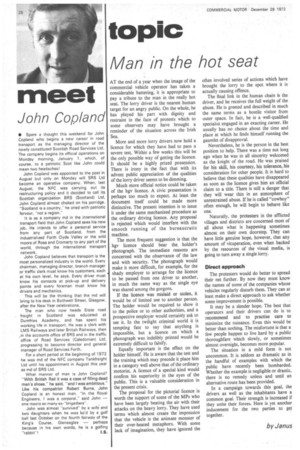topic
Page 30

If you've noticed an error in this article please click here to report it so we can fix it.
Man in the hot seat
AT the end of a year when the image of the commercial vehicle operator has taken a considerable battering, it is appropriate to pay a tribute to the man in the really hot seat. The lorry driver is the nearest human target for an angry public. On the whole, he has played his part with dignity and restraint in the face of protests which to some observers may have brought a reminder of the situation across the Irish Sea.
More and more lorry drivers now hold a licence for which they have had to pass a severe test. Within a few weeks this will be the only possible way of getting the licence. It should be a highly prized possession. There is irony in the fact that with its advent public appreciation of the qualities of the lorry driver seems to be dimming.
Much more official notice could be taken of the hgv licence. A civic presentation is perhaps too much to expect. At least the document itself could be made more distinctive. The present intention is to issue it under the same mechanized procedure as the ordinary driving licence. Any proposal is rejected which would interfere with the smooth running of the bureaucratic machine.
The most frequent suggestion is that the hgv licence should bear the, holder's photograph. The immediate reasons are concerned with the observance of the law and with security. The photograph would make it more difficult, for example, for the shady employer to arrange for the licence to be passed from one driver to another, in much the same way as the single eye was shared among the gorgons.
If the licence was mislaid or stolen, it would be of limited use to another person. The holder would be required to show it to the police or to other authorities, and a prospective employer would certainly ask to see it. In the twilight criminal world it is tempting fate to say that anything is impossible, but a licence on which a photograph was indelibly printed would be extremely difficult to falsify.
Equally important is the effect on the holder himself. He is aware that the test and the training which may precede it place him in a category well above that of the ordinary motorist. A licence of a special kind would confirm his superiority in the eyes of the public. This is a valuable consideration in the present crisis.
The proposal for the pictorial licence is worth the support of some of the MPs who have been largely beating the air with their attacks on the heavy lorry. They have used terms which almost create the impression that the vehicle is the animate monster of their over-heated metaphors. With some lack of imagination, they have ignored the often involved series of actions which have brought the lorry to the spot where it is actually causing offence.
The final link in the human chain is the driver, and he receives the full weight of the abuse. He is greeted and described in much the same terms as a hostile visitor from outer space. In fact, he is a well-qualified specialist engaged in an exacting career. He usually has no choice about the time and place at which he finds himself running the gauntlet of disapproval.
Nevertheless, he is the person in the best position to help. There was a time not long ago when he was in all sincerity welcomed as the knight of the road. He was praised for his skill, his courtesy, his tolerance, his consideration for other people. It is hard to believe that these qualities have disappeared as soon as the licence gives him an official claim to a title. There is still a danger that they will wear thin in an atmosphere of unrestrained abuse. If he is called "cowboy" often enough, he will begin to behave like one.
Naturally, the protesters in the afflicted villages and districts are concerned most of all about what is happening sometimes almost on their own doorstep. They can have little genuine hope, however, that any amount of vituperation, even when backed by the resources of the visual media, is going to turn away a single lorry.
Direct approach The protesters would do better to spread their net further. By now they must know the names of some of the companies whose vehicles regularly disturb them. They can at least make a direct approach to ask whether some improvement is possible.
It may be a slender hope. The best that operators and their drivers can do is to recommend and to practise care to minimize the nuisance. Even this would be better than nothing. The misfortune is that a few people happen to live hard by a public thoroughfare which slowly, or sometimes almost overnight, becomes more popular.
The situation in a mild form is not uncommon. It is seldom as dramatic as in the handful of examples with which the public have recently been bombarded. Whether the example is negligible or drastic, there is no remedy unless and until an alternative route has been provided.
In a campaign towards this goal, the drivers as well as the inhabitants have a common goal. Their strength is increased if they unite their forces. Here is yet another inducement for the two parties to get together.
by Janus












































































